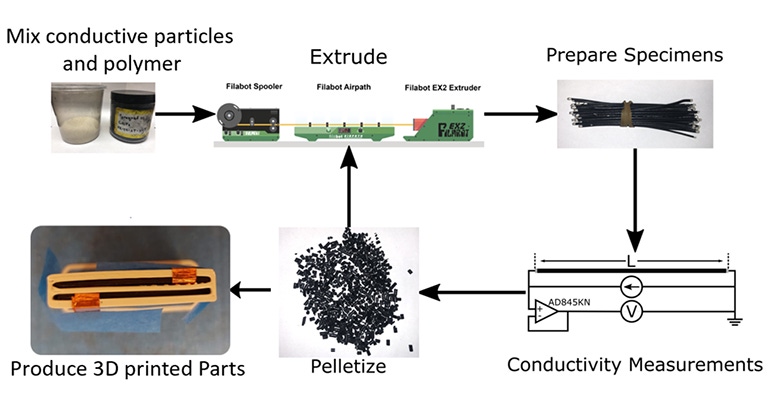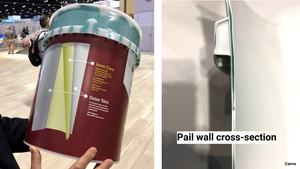Novel Wet-Mixing Method Evenly Disperses Sensors Within 3D-Printed Parts
The technique developed by Purdue University researchers embeds sensor particles in the 3D-printing filament, expanding the design envelope for fully functional parts in a range of shapes.
November 29, 2022

A patent-pending wet-mixing method developed by Purdue University researchers allows the even dispersal of electrically conductive particles within filament polymers for fused deposition modeling–based 3D printing. The breakthrough embeds sensing capabilities inside the 3D-printed part, making it possible to rapidly convert prototypes into fully functional components.
Traditional 3D printing makes prototypes with no sensing capabilities, explained a press release from Purdue, adding that sensors must be added to the part after the fact if assessments are to be made. The process is analogous to adding sprinkles to cookies after they are baked. “The sprinkles exist only on the outside of the cookie. Traditional foil-type strain gauges, which are the most common strain sensors, are adhered to the surface of a printed part by an epoxy resin," explained Brittany Newell, associate professor in the School of Engineering Technology in the Purdue Polytechnic Institute. “However, in this work the sprinkles are added throughout the cookie dough before baking. This means that sensing capabilities are an inherent part of the printed component and allow for sensing inside of the component. Unlike sprinkles, these sensors are too small to be seen without a microscope. Their tiny scale allows the printed part to maintain strength it would have otherwise sacrificed due to large sensors built in, while still achieving fully integrated sensing capabilities,” said Newell.
Newell, fellow associate professor Jose M. Garcia-Bravo, and Tyler Tallman, assistant professor in the School of Aeronautics and Astronautics in the College of Engineering, created the wet-mixing method with crucial contributions from Cole Maynard, who earned his PhD in August, and doctoral candidate Julio Hernandez.
The Purdue wet-mixing method ensures an even distribution of particles throughout the filament. With the sensors dispersed evenly in the filament, manufacturers and researchers can design parts with a wider variety of shapes, said the press release.
“The results from this work enable users to create complex 3D structures with embedded strain gauges, rapidly moving traditional prototype pieces into fully functional and structurally assessable parts,” Newell said. “A limitation of application of 3D printed parts has been in their durability. With this development, we can continually monitor the structural health of the part with the sensor embedded in the print.”
The technique greatly expands the electrical applications of 3D-printed parts and sensor designs, according to the researchers, and the electrical and mechanical properties can be “tuned” to optimize the sensor or part for a desired application.
The novel wet-mixing process is not limited to sensor conductivity, added Newell. “This work can be further expanded to add other particle types using the same wet-mixing method. This could include the addition of magnetic particles for electromagnetic fields, fluorescent particles, and other functionalities,” said Newell.
The research was published in the July 2022 edition of the peer-reviewed journal Advanced Engineering Materials and in the 2020, 2021, and 2022 editions of the journal American Society of Mechanical Engineers Smart Materials, Adaptive Structures and Intelligent Systems. The researchers have received funding from the Naval Engineering Education Consortium, a program from the NAVSEA warfare centers aiming to cultivate partnerships between the Navy and higher education institutions.
The researchers disclosed the innovation to the Purdue Research Foundation Office of Technology Commercialization, which has applied for a patent on the intellectual property. Industry partners seeking to further develop this innovation should contact Dhananjay Sewak, [email protected], citing reference number 69740.
About the Author(s)
You May Also Like




